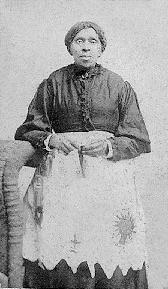Harriet Powers
| Harriet Powers | |
|---|---|

Photograph of Harriet Powers (1901)
|
|
| Born |
Harriet Powers Clarke County, Georgia |
| Died | January 1, 1910 (aged 72) Clarke County, Georgia |
| Nationality | American |
| Known for | Quilting |
| Notable work |
Bible Quilt 1886 Bible Quilt 1898 |
Harriet Powers
Harriet Powers (October 29, 1837 – January 1, 1910) was an African-American slave, folk artist, and quilt maker from rural Georgia. She used traditional appliqué techniques to record local legends, Bible stories, and astronomical events on her quilts. Only two of her quilts are known to have survived: Bible Quilt 1886 and Pictorial Quilt 1898. Her quilts are considered among the finest examples of nineteenth-century Southern quilting. Her work is on display at the National Museum of American History in Washington, DC, and the Museum of Fine Arts in Boston, Massachusetts.
Powers was born into slavery near Athens, Georgia. Historians say she spent her early life on a plantation owned by John and Nancy Lester in Madison County, Georgia, where it is believed she learned to sew, either from other slaves or from her mistress.
Though an 1895 Chicago Tribune article about the Cotton States and International Expo characterizes Powers as “ignorant” and illiterate, only learning Bible stories from “others more fortunate,” quilt historian Kyra E. Hicks discovered during research for her book "This I Accomplish: Harriet Powers' Bible Quilt and Other Pieces" a letter written by Powers explaining how she came to be literate and that she learned the bible stories, which served as the inspiration for her quilt work storytelling through her own study of the bible.
In 1855, at the age of eighteen, Powers married Armstead Powers. They had at least nine children. In the 1880s, after being freed at the end of the Civil War, they owned four acres of land and had a small farm. During the 1890s, due to financial difficulty, her husband slowly sold off parcels of their land, defaulted on taxes, and eventually left Harriet and their farm in 1895. Powers never remarried and probably supported herself as a seamstress. For most of her life she lived in Clarke County, mainly in Sandy Creek and Buck Branch.
...
Wikipedia
